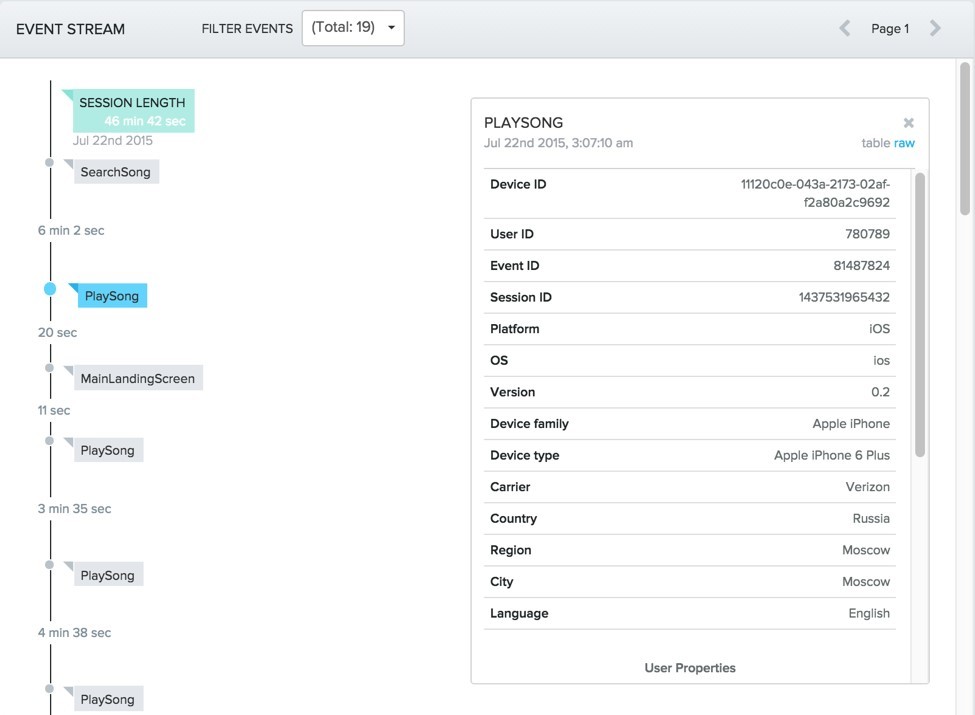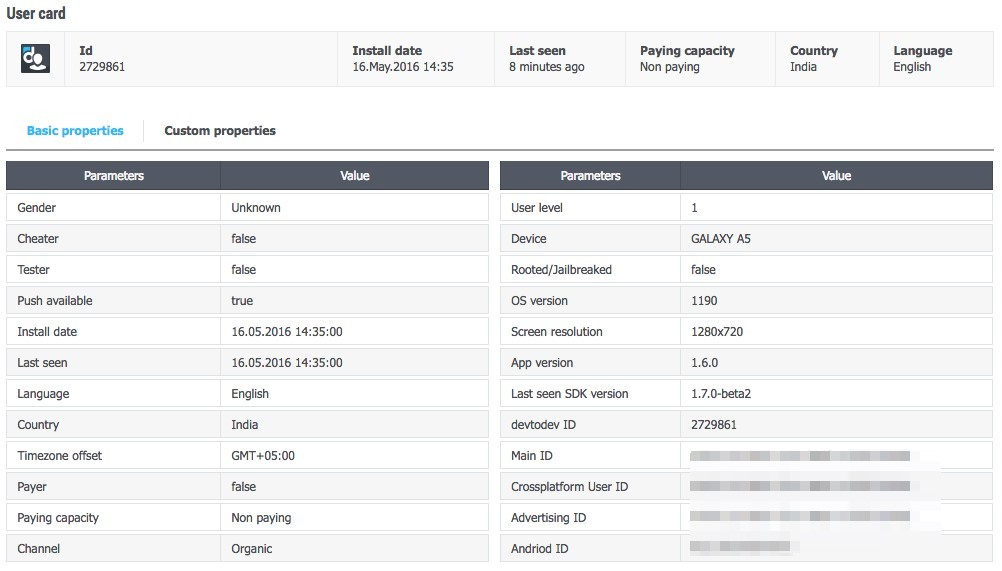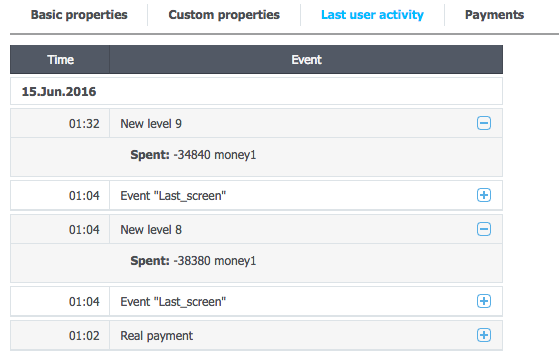User profiles in analytics, or how to become Sherlock Holmes
If you read stories about Sherlock Holmes, or watched numerous screen versions, you probably remember the name of the method that the hero uses to uncover confused cases. Just in case, we recall: he uses induction - the transition from the particular to the general as opposed to deduction, when it is concluded from general data that it is private. How to use the induction method to study the behavior of users in our application? .. "Elementary!" - said the hero of Sir Arutra Conan Doyle. “Exactly so,” says leading devtodev analyst Vasily Sabirov.

image source www.smartdatacollective.com/sites/smartdatacollective.com/files/Sherlock-Holmes-Big-Data-Analytics-and-BI-Attivio.png
Until recently, most analytical systems offered work using the deductive method: all users were analyzed at once, and the conclusion was made about the behavior of each particular user. This cannot be considered a mistake, but for more accurate conclusions, it is still worthwhile to use the inductive method. And now the devtodev service is pleased to present a new functionality of analytical systems, based on the inductive method: analysis of user profiles .
')
If you set out to more accurately understand your project, then first you build analytics into it and start to see certain metrics (DAU, ARPU, LTV, and so on) and reports. Does this mean that you fully understand the project you are working on? Not really. Yes, you can draw conclusions about the behavior of the majority, but you will not be able to look at the project through the eyes of a specific user.
To see the product from this point of view, you need to follow the behavior of a particular user: what actions he performs, what problems he encounters, whether he understands the essence of your product. Having followed each user and having learned what actions he performs inside the product, you will no doubt be able to understand it better.

User profiles in Amplitude
image source amplitude.zendesk.com/hc/en-us/article_attachments/202671468/User_Search_2.png
By analyzing the N users in this way, you can collect the data necessary to formulate a number of hypotheses about the improvement of the product. And their number certainly will not be less than the results of the analysis of metrics for all users at once. Practice shows that N doesn’t have to be big at the same time: when studying in detail already on the third user, you formulate some hypotheses, on the fifth, you identify problems, and on the tenth in your head, plans for changing and improving the product mature.

image source www.ew.com/sites/default/files/1452454622/christian-bale_0_1.jpg
Another example from a piece of artwork, this time is the movie “The Game for the slide”. The attentive viewer remembers how the hero Christian Bale examines a huge table with mortgage loans taken by each specific borrower, and then interrogates these very people, thus finding the preconditions for the coming financial crisis. Banks, who are accustomed to assessing the overall situation, and not every single case, do not believe in the approach of the end, since the overall situation is excellent, and nothing foretells a collapse. What is not a vivid example of an erroneous analysis?
As a result, the following trend is formed: many analytical systems on the market launch their modules, providing the ability to analyze user profiles. Localytics has Profiles, Mixpanel has People, and Amplitude has User Activity.
In devtodev, we created an advanced version of such a module and called it Users .
What is the profile of the user?
First, this is information that is collected by the default analytical system:
Using this information, you can filter users by certain parameters, create segments and monitor their behavior in the future. Suppose you can select all users from the iPad, all from France, all who came from Facebook, all who use the previous version of the application, and so on. Filters can be combined to target point-selected audiences: English-speaking users from Western Europe using the new version of the application and registering with the service no more than two months ago.

Secondly, the profile stores information about the user's payments: when he paid, how much and for what. You seem to try on his profile on yourself and begin to better understand the motive of his actions: why he bought this particular IAP, why so much time elapsed between payments, and so on.

Without user profiles, you can see monetization metrics, purchase statistics, and this is certainly very useful information. However, a deeper understanding is achieved precisely by moving to the player level.
Thirdly, the user profile includes statistics of events (custom events ) that occurred with the user in the project. You start to see their sequence, you kind of watch a video about how a particular person uses your product.
Here are some examples of questions that can be answered using this method:

You can select all users who entered the app store (who made the “Store Entry” event) and evaluate which events preceded this entry and what the user’s behavior was after entering the store. So it will become clearer how the user is converted and in the interest in the purchase, and directly in the transition to the purchase, and as a result in a successful perfect payment.

User Profiles in the MixPanel System
Source for the image cdn.mxpnl.com/cache/81e4c82a27f699ba6153b46064105a1e/images/static/landing/marketing/people2/feature-illus.png
Finally, the user profile includes User Properties that you yourself define. It can be anything: the level of the game, the group code when conducting the A / B test, the classification by the value of payment activity (minnow / dolphin / whale) and so on.
You will save enough on all the drafts of standard methods, and the most correct tactic of the analytical system will form a universal set of useful parameters for tracking user actions, while leaving the client the opportunity to choose any other parameter for analysis.
The practical benefits of having user profiles in the analytics system are obvious, for those who doubt, I will give arguments:
A case from practice: application developers noticed that the user was stuck at some level, and sent him a notification with a hint how to pass this level. Then it turned out that he is not the only one, and a significant number of users get stuck at the same level, and then leave the application for an average of seven days. While everyone was writing a simplified level statement (I wanted the users not to leave), you’ve sent a push-notification to everyone stuck at the level with an explicit hint. What was done with those who did not enter the game for seven days or more? That's right, they sent out a small but pleasant bonus in virtual currency using the same push notifications, using the transmitted parameters.

Thus, the analysis of user profiles greatly simplifies the life of the client of the analytical system, and the system itself, leaving the modern Sherlock Holmes out of work. The client has much more opportunities to evaluate user actions, and the main one is the possibility of conducting inductive analysis (“vice versa” analysis). It is important that the system itself remains the winner, gaining even greater trust from the client.

image source www.smartdatacollective.com/sites/smartdatacollective.com/files/Sherlock-Holmes-Big-Data-Analytics-and-BI-Attivio.png
Until recently, most analytical systems offered work using the deductive method: all users were analyzed at once, and the conclusion was made about the behavior of each particular user. This cannot be considered a mistake, but for more accurate conclusions, it is still worthwhile to use the inductive method. And now the devtodev service is pleased to present a new functionality of analytical systems, based on the inductive method: analysis of user profiles .
')
If you set out to more accurately understand your project, then first you build analytics into it and start to see certain metrics (DAU, ARPU, LTV, and so on) and reports. Does this mean that you fully understand the project you are working on? Not really. Yes, you can draw conclusions about the behavior of the majority, but you will not be able to look at the project through the eyes of a specific user.
To see the product from this point of view, you need to follow the behavior of a particular user: what actions he performs, what problems he encounters, whether he understands the essence of your product. Having followed each user and having learned what actions he performs inside the product, you will no doubt be able to understand it better.

User profiles in Amplitude
image source amplitude.zendesk.com/hc/en-us/article_attachments/202671468/User_Search_2.png
By analyzing the N users in this way, you can collect the data necessary to formulate a number of hypotheses about the improvement of the product. And their number certainly will not be less than the results of the analysis of metrics for all users at once. Practice shows that N doesn’t have to be big at the same time: when studying in detail already on the third user, you formulate some hypotheses, on the fifth, you identify problems, and on the tenth in your head, plans for changing and improving the product mature.

image source www.ew.com/sites/default/files/1452454622/christian-bale_0_1.jpg
Another example from a piece of artwork, this time is the movie “The Game for the slide”. The attentive viewer remembers how the hero Christian Bale examines a huge table with mortgage loans taken by each specific borrower, and then interrogates these very people, thus finding the preconditions for the coming financial crisis. Banks, who are accustomed to assessing the overall situation, and not every single case, do not believe in the approach of the end, since the overall situation is excellent, and nothing foretells a collapse. What is not a vivid example of an erroneous analysis?
As a result, the following trend is formed: many analytical systems on the market launch their modules, providing the ability to analyze user profiles. Localytics has Profiles, Mixpanel has People, and Amplitude has User Activity.
In devtodev, we created an advanced version of such a module and called it Users .
What is the profile of the user?
First, this is information that is collected by the default analytical system:
- installation date;
- tongue;
- a country;
- Timezone;
- Device (device);
- OS version;
- traffic channel;
- version of the application;
- etc.
Using this information, you can filter users by certain parameters, create segments and monitor their behavior in the future. Suppose you can select all users from the iPad, all from France, all who came from Facebook, all who use the previous version of the application, and so on. Filters can be combined to target point-selected audiences: English-speaking users from Western Europe using the new version of the application and registering with the service no more than two months ago.

Secondly, the profile stores information about the user's payments: when he paid, how much and for what. You seem to try on his profile on yourself and begin to better understand the motive of his actions: why he bought this particular IAP, why so much time elapsed between payments, and so on.

Without user profiles, you can see monetization metrics, purchase statistics, and this is certainly very useful information. However, a deeper understanding is achieved precisely by moving to the player level.
Thirdly, the user profile includes statistics of events (custom events ) that occurred with the user in the project. You start to see their sequence, you kind of watch a video about how a particular person uses your product.
Here are some examples of questions that can be answered using this method:
- What event usually follows event A?
- what event precedes event b?
- Do all users execute event C after event D? or go to event E?
- What events precede the user's departure from the project?

You can select all users who entered the app store (who made the “Store Entry” event) and evaluate which events preceded this entry and what the user’s behavior was after entering the store. So it will become clearer how the user is converted and in the interest in the purchase, and directly in the transition to the purchase, and as a result in a successful perfect payment.

User Profiles in the MixPanel System
Source for the image cdn.mxpnl.com/cache/81e4c82a27f699ba6153b46064105a1e/images/static/landing/marketing/people2/feature-illus.png
Finally, the user profile includes User Properties that you yourself define. It can be anything: the level of the game, the group code when conducting the A / B test, the classification by the value of payment activity (minnow / dolphin / whale) and so on.
You will save enough on all the drafts of standard methods, and the most correct tactic of the analytical system will form a universal set of useful parameters for tracking user actions, while leaving the client the opportunity to choose any other parameter for analysis.
The practical benefits of having user profiles in the analytics system are obvious, for those who doubt, I will give arguments:
- With the help of this module, you can perform the analysis “vice versa”, or inductive analysis, if you want. You watch the behavior of specific users and begin to better understand how they feel when using your product.
- Based on the analysis performed, you can send push notifications to selected users - some systems (including devtodev ) allow you to do this.
A case from practice: application developers noticed that the user was stuck at some level, and sent him a notification with a hint how to pass this level. Then it turned out that he is not the only one, and a significant number of users get stuck at the same level, and then leave the application for an average of seven days. While everyone was writing a simplified level statement (I wanted the users not to leave), you’ve sent a push-notification to everyone stuck at the level with an explicit hint. What was done with those who did not enter the game for seven days or more? That's right, they sent out a small but pleasant bonus in virtual currency using the same push notifications, using the transmitted parameters.

- Using user profiles, it is easy to test the integration of an analytical system . In general, the integration of the analytics process is not difficult, but rather painstaking: you first need to form a set of events, clearly realizing that these events will be enough for subsequent conclusions (I wrote about it in more detail here). And when integration is complete, it would not hurt to test it thoroughly. And here, user profiles and real-time analytics work will be a good help: you open the application yourself, make a chain of events, then find your profile in the analytics and just see if the events were transmitted correctly with the parameters. If the analytics are not tested correctly, then the iteration for correction may take more than a month, which could be devoted to more necessary things.
- Finally, the credibility of the analytical system increases . Suppose that this very system counted something for you (for example, ARPU = $ 0.2), and you do not know how this value was obtained and whether you can trust it at all. As a representative of the analytical service, I will say that you can trust, but I perfectly understand people who have a slight distrust of the system, considering it to be a black box. Often, people working with data will want to upload the data themselves and double-check everything by hand. The presence of user profiles increases the credibility of the analytics system: you see not bare figures, but data for each user separately, but the ability to upload data just allows particularly suspicious people to upload data and count everything themselves. Thus, the availability of user profiles is mutually beneficial for both the client and the analytical system itself.
Thus, the analysis of user profiles greatly simplifies the life of the client of the analytical system, and the system itself, leaving the modern Sherlock Holmes out of work. The client has much more opportunities to evaluate user actions, and the main one is the possibility of conducting inductive analysis (“vice versa” analysis). It is important that the system itself remains the winner, gaining even greater trust from the client.
Source: https://habr.com/ru/post/304668/
All Articles